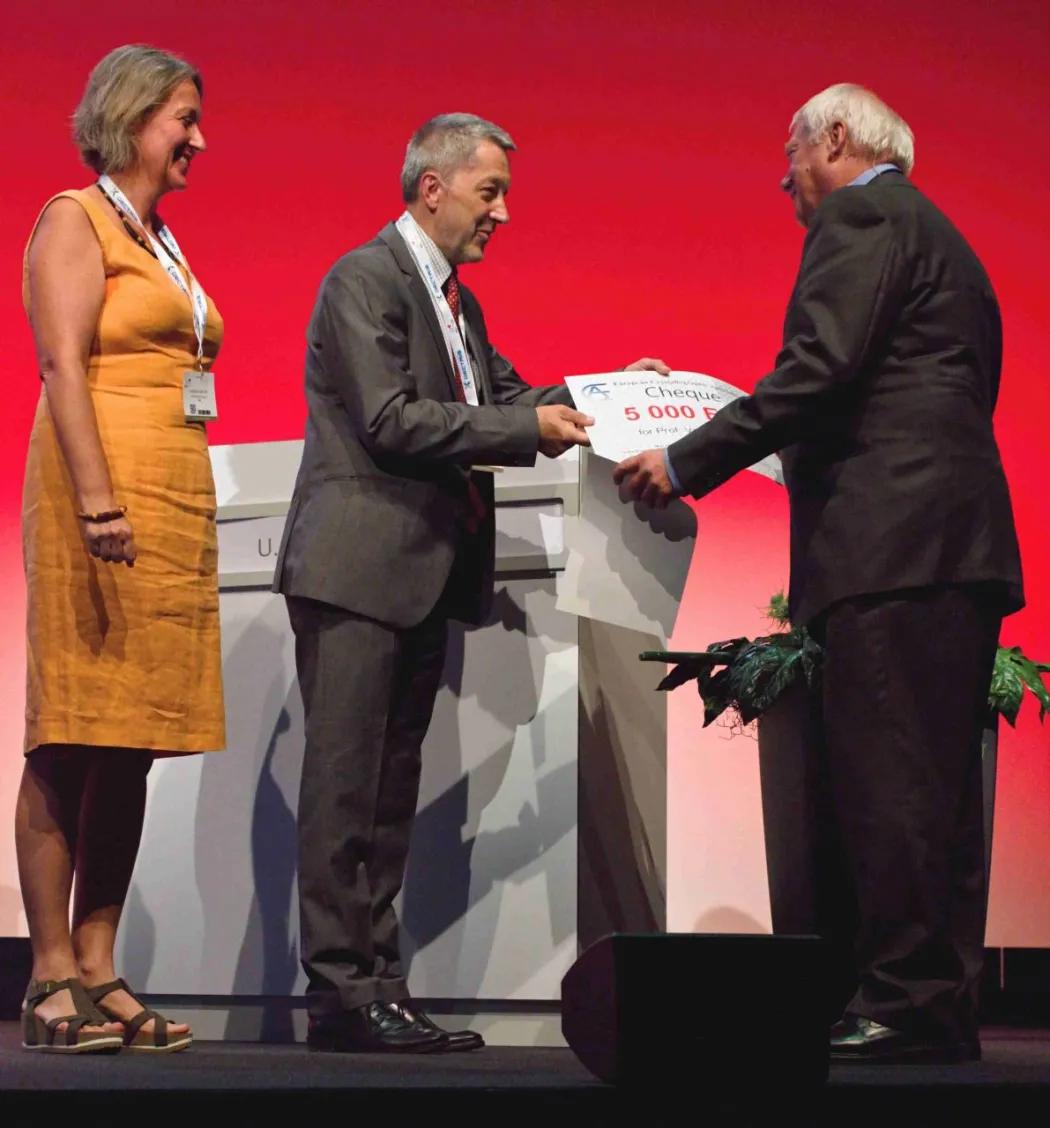The 9th Max Perutz prize has been awarded to Václav Petříček from the Institute of Physics of the Czech Academy of Sciences during the opening ceremony of the 30th European Crystallographic Meeting on August 28th, 2016 in Basel (Switzerland). Václav Petříček is recognized for his contribution to the practical application of the theory of aperiodic structures in his computing system JANA. The Max Perutz Prize is awarded every first and second year, followed by the triennial Ewald prize of the International Union of Crystallography.
Both prizes represent the highest appreciation in the field of crystallography as it is best illustrated by a list of previous awardees: Ada Yonath, Jochen R. Schneider, Carmelo Giacovazzo, George Sheldrick, Eleanor J. Dodson, David Stuart, Claude Lecomte, Hartmut Fueß, Randy J. Read and John Helliwell. The prize confirms the growing importance and influence of the Czech crystallographic community in the worldwide context.
Václav Petříček has obtained his Max Perutz prize for the development of the crystallographic computing system JANA [1]. Two previous awardees were recognized for similar work: Carmelo Giacovazzo (programs SIR and EXPO for the solution of crystal structure by direct methods, [2]) and George Sheldrick (the program SHELX for refinement of structures from single-crystal diffraction data, [3]). Indeed, the scientific careers of these three extraordinary scientists have common features. They started in proper time with a topic theoretically mastered but not commonly used, and they wrote their computer programs to remove the obstacles and make the theory useful for a wide public. Moreover, they not only wrote their programs in the proper time, but they have also devoted their scientific careers to further develop their programs into systems indispensable for crystallographers.
The success of JANA is all the more fascinating in the light that Václav was working on a wrong side of the Iron Curtain, where conditions were quite inappropriate for scientific work, and that at the beginning the topic of modulated structures was quite marginal. The history of JANA starts in 1983 during the stay of Václav at the laboratory of Phillip Coppens in Buffalo in the United States. Phillip has recognized the importance of modulated structures from the very beginning and this was his idea that Václav started with the development of a refinement program for this kind of compounds. JANA was not the first program for modulated structures; the same topic was covered also by program REMOS created by Akiji Yamamoto [4]. However, REMOS has been always quite difficult to use, while JANA has been more and more user-friendly during the time. In 1996, it got the first graphical interface and the growth of a number of users has accelerated, so that JANA98 had already hundreds of users. Currently, almost every modulated structure is solved with JANA, and the program gets about 300 citations per year.
Universality is the most remarkable feature of JANA. We can annotate the latest versions of the program like „crystallographic computing system for refinement of atomic and magnetic structures of arbitrary dimension from any diffraction data“. Indeed, JANA can work with diffraction data from x-ray, neutron and electron sources acquired for single crystal as well as powder data, and it can calculate standard, modulated and magnetic structures. JANA also contains various interpretation tools for electron density maps and geometric parameters. Accordingly, the computer code of JANA contains almost complete crystallography. The chance that Václav could obtain the Max Perutz prize appeared realistic during several last years because the number of modulated structures has been growing rapidly and the importance of JANA has been quite obvious. The influence of workshops on JANA with ~1000 participants during the last six years was also remarkable, but the most important was the fact that there was no stagnation in the development of JANA. It now covers the hot topics of crystallography like electron diffraction, where JANA interfaces the unique tools of Lukáš Palatinus [5], and neutron diffraction on magnetic compounds, where Václav has given an actual shape to his old idea of the „crystallographic approach“ to magnetic structures utilizing symmetry of the diffraction pattern [6].
The next version of the program with a provisional name JANA2018 will especially enhance the user interface, using a plot of crystal structure for controlling refinement parameters. Welcomed and appreciated are the efforts of Václav to document the immense treasure of the computing methods hidden in JANA in a form of review articles. Up to now, there is the introduction to JANA [7], a work about discontinuous functions [8], and recently accepted work about twinning [9]. Let's wish Václav many happy years with the computing system JANA2018!
[1] http://jana.fzu.cz
[2] http://wwwba.ic.cnr.it/content/software
[3] http://shelx.uni-ac.gwdg.de/SHELX/
[4] Yamamoto, A. (1982). Acta Cryst. A38, 87-92
[5] Palatinus, L., Petříček, V. & Correa, C.A. (2015). Acta Cryst. A 71, 235-244
[6] Petříček, V., Fuksa, J. & Dušek, M. (2010). Acta Cryst. A66, 649-655
[7] Petříček, V., Dušek, M. & Palatinus, L. (2014). Z. Kristallogr. 229, 345-352
[8] Petříček, V., Eigner, V. & Dušek, M. (2016). Z. Kristallogr. 231, 301-312
[9] Petříček, V., Dušek, M. & Plášil, J. (2016). Z. Kristallogr. 231, accepted
